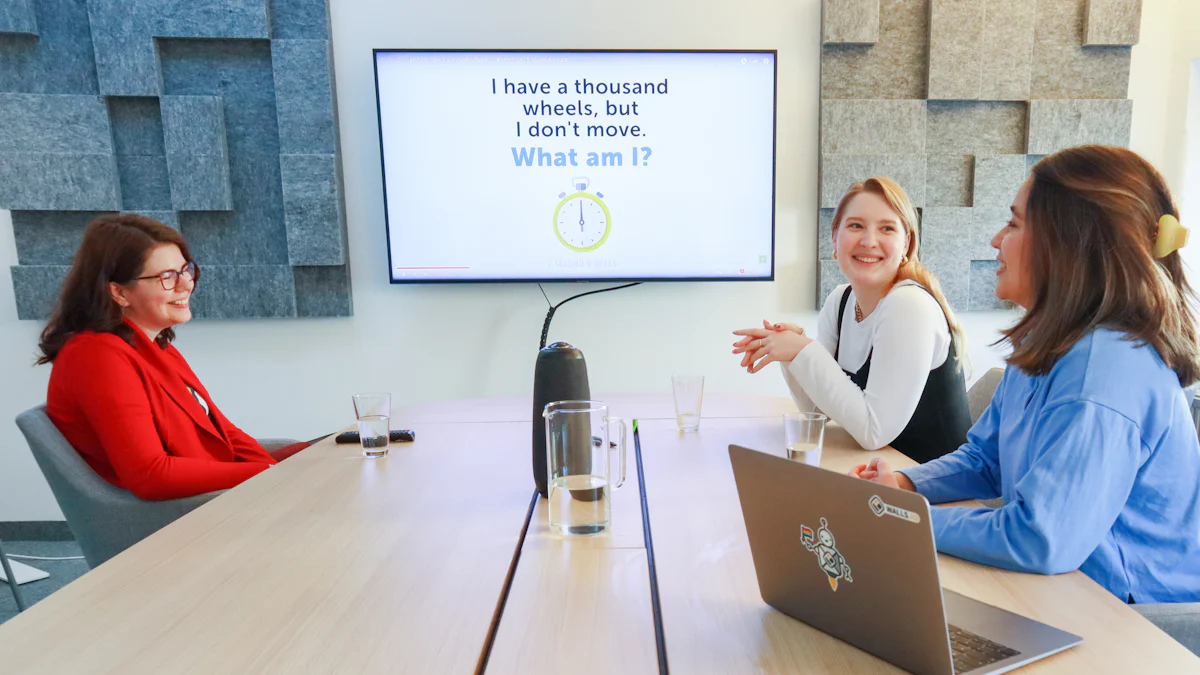check in questions for meeting

Meetings are key for team work and getting things done. Adding check-in questions to your meetings can make them much better. Starting with a simple check-in helps everyone talk openly and connect more. Knowing how to make good questions that fit your team is important. This helps get the most out of these talks. Let's explore check-in questions and see how they can change meeting times.
Types of Check-In Questions

Icebreaker Questions
Icebreaker questions start meetings on a happy note. They make everyone feel relaxed and ready to share. These questions can be easy, like asking about favorite movies or weekend plans. Starting with an icebreaker sets a friendly tone for the talk.
Examples of Icebreaker Questions
What always makes you smile?
What's your favorite karaoke song?
If you had a superpower, what would it be?
When to Use Icebreaker Questions
Use icebreakers at the start of meetings or when new members join. They help build friendships and create a welcoming mood. In long meetings, use icebreakers to keep energy high and people engaged.
Progress Check Questions
Progress check questions see how things are going in your team or project. They help find out what has been done, spot problems, and make sure everyone knows the goals. Regular progress checks catch issues early and celebrate wins together.
Examples of Progress Check Questions
What have we achieved since our last meeting?
Are there any problems stopping us from moving forward?
How sure are you about meeting our next deadline?
Benefits of Progress Check Questions
These questions help team members be open and responsible. They encourage talking about successes and challenges, building teamwork and continuous improvement.
Emotional Check-In Questions
Emotional check-in questions ask how team members feel beyond work stuff. These show you care about their well-being and let them share their true feelings. Knowing emotions helps give better support and build stronger bonds in the team.
Examples of Emotional Check-In Questions
On a scale from 1 to 5, how stressed are you today?
What's something outside work that makes you happy recently?
Is anything on your mind that might affect your focus today?
Importance of Emotional Check-Ins
Emotional check-ins make teams better by recognizing feelings and promoting empathy among members. Talking about emotions openly builds trust, lowers stress, and improves overall happiness at work.
Feedback Questions
Examples of Feedback Questions
How can we make our work better?
When did you feel your ideas were ignored?
Do you feel okay giving feedback to others?
Using Feedback Questions Well
To use feedback questions well, ask them nicely and clearly. Tell team members to share their thoughts without fear. Valuing feedback brings good ideas and helps the team grow.
When asking for feedback, be clear about what you want to know. This makes answers more useful and less vague. Remember, feedback goes both ways; accept criticism and thank everyone for their input.
How to Use Check-In Questions in Meetings
Getting Your Questions Ready
When getting your questions ready, think about what matters to your team. Make sure the questions fit your team's needs and goals. Think about each person's personality and work style. This makes the check-ins more fun and useful.
When and How Often to Check In
Choosing when to check in is important. Pick times when everyone is there and paying attention. Do it regularly to build trust and routine. Don't do it too often, but enough to stay connected.
Getting Everyone Involved
To get everyone involved, make a safe space where people feel okay sharing. A safe space helps people talk honestly and work together better. Use ways that help everyone listen and respect different ideas.
Ways to Get Everyone Talking
Make sure everyone gets a chance to talk during meetings. Try things like taking turns or small group talks. Help quieter members share their thoughts too; they might have great ideas.
Looking at Answers
After you get answers, find useful information from them. Look for common problems or successes in the answers. Use this information to make good decisions and fix any issues.
Using Feedback to Make Meetings Better
Feedback from check-ins can help improve future meetings. Show that you care about what your team says by using their feedback well. Make changes that help meetings run smoothly and create a happy workplace.
Common Challenges and Solutions

Overcoming Resistance
If team members resist meeting check-ins, it can slow progress. Listen to their concerns first. Understand why they are hesitant. Show them the value of check-ins by explaining how it keeps everyone informed and connected.
Addressing Concerns and Misconceptions
Addressing concerns is key to overcoming resistance. Some worry that meetings will get too personal or take too long. Reassure them that check-in questions improve communication and teamwork without invading privacy.
Demonstrating the Value of Check-Ins
Showing the value of check-ins helps win over skeptics. Highlight benefits like quick updates, team unity, and project awareness that check-in questions bring. Once they see the positive impact, they will likely embrace this practice.
Ensuring Consistency
Consistency in using check-in questions is vital for their success. By setting a routine for meetings, you create an expectation among team members. This routine helps everyone prepare to share updates and discuss challenges regularly.
Setting a Routine
Setting a routine for check-ins creates a reliable pattern for team members. Start every meeting with an icebreaker or end with feedback questions. Consistency builds trust and engagement within the team.
Adapting to Different Meeting Types
Adapting check-in questions to different meetings ensures relevance and engagement in various scenarios. Tailor your questions based on the meeting's purpose—whether it's a project update or brainstorming session—to keep discussions focused and productive.
Balancing Depth and Brevity
Balancing depth and brevity in check-in questions is essential for meaningful talks without overwhelming participants. Keep questions short yet open-ended to encourage thoughtful responses while allowing room for deeper insights when needed.
Keeping Questions Concise
Keeping meeting check-in questions short helps maintain focus during discussions. Avoid complex queries that may lead to confusion or long answers. Clear, simple questions yield clearer insights from team members.
Allowing for In-Depth Responses When Necessary
While brevity is important, allow space for detailed responses when needed. For complex issues or new ideas, let team members elaborate freely on their thoughts. This balance ensures thorough talks without losing efficiency.
Starting your meetings with check-in questions makes everyone feel good. Knowing why these questions matter helps make talks better. Using different types of check-ins that fit your team can improve talking and teamwork. Good results come from asking the right questions that your team cares about.
See Also
Creating a Compelling Meeting Agenda for Administrators
Comparing EMEET Meeting Capsule and Meeting Owl Cameras
Perfecting the Hosting of Hybrid Zoom Meetings

